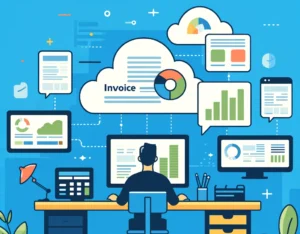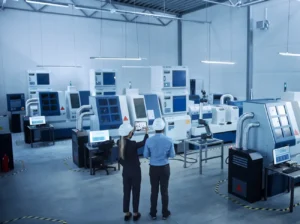How do you ensure your company gets paid what it’s owed? All too many business owners fail to recognize the importance of invoices in operational sustainability and growth. Invoices have evolved from just a piece of paper; invoices are critical to the success and continued growth of your business. Even more important is how you generate, deliver, and manage your invoices. Our guide to invoice automation software and automated invoice processing will break down everything there is to know about managing invoices with software, ensuring your invoicing process eliminates manual errors and saves time when it matters most.
What is an Invoice?
An invoice is a document that provides a detailed breakdown of the costs associated with acquiring goods or services. Businesses use them to formally request payment from customers and record transactions. Every transaction should have an associated invoice to ensure parties on both ends are on the same page regarding billing amounts and timelines.
An invoice typically includes the date of purchase, a unique invoice number for record-keeping purposes, the name and contact information of both parties involved in the transaction (i.e. business and customer), a description of the goods or services provided, quantities purchased, or services provided, as well as the cost or rate of each item. Invoices should also include any taxes, shipping or handling fees, and discounts if they apply.
What Makes an Invoice, an Invoice?
What makes an invoice is not the specific items included, but rather the intention behind it. Both sides of a transaction know that they can reference this document as a record of their exchange, like a contract. Terms, disclosures, dates, and signatures all validate their agreement and make it official.<
Types of Invoices
With the basic definition being clear, it’s important to recognize that an invoice’s layout can vary depending on the circumstances in which it’s used. See a few examples of common types of invoices with their respective use cases below.
Standard Invoice
The most common type of invoice, the standard invoice is used for selling goods or services where payment is due upon receipt. It typically includes basic information such as a description of the item or service, quantity, price per unit, and the total amount due. This type of invoice is usually used for smaller transactions and does not have any specific payment terms.
Recurring Invoice
A recurring invoice is used when a business provides services on an ongoing basis, such as monthly or yearly subscriptions. It includes the same information as a standard invoice but also specifies the length of time for which the service will be provided and when payment is due.
Credit Invoice
Credit invoices are issued when there are changes to a previous invoice, such as a refund or credit for returned goods. They typically include the original invoice number and any adjustments that were made, such as a discount or additional charges.
Time-Based Invoice
Time-based invoices are used when billing for services based on the time spent on a project. They include the date, time period, and rate for each service provided and the total amount due.
Commercial Invoice
A commercial invoice is used for international shipments and includes additional information such as the country of origin, the description of goods being shipped, and any applicable customs duties or fees.
Proforma Invoice
A proforma invoice or preliminary bill of sale, outlines the estimated costs of goods or services before a final invoice is issued. It makes the most sense to use this type of invoice when the final price is uncertain, such as in the case of a custom order or project.
Creating an invoicing process
It is important to create an effective invoicing process to ensure accuracy, efficiency, and compliance. How you manage invoices can be crucial to your bottom line. Most businesses opt for a manual or an automated process. With either method, you should start with defining a policy including terms and conditions, due dates, accepted payments, and invoice formats that align with your business needs.
Common Challenges in Manual Invoice Processing
What is Manual Invoice Processing?
Manual invoice processing is the old-school way of creating, sending, and paying invoices. It’s a tedious process that relies on paper documents and human effort to complete each step in the process. More advanced manual processes include digital documents that require manual data entry and delivery. While manual invoice processing may have been the only way to do things in the past, the strategy is quickly being made redundant by modern-day solutions.
Here are just a few examples of what the consequences of manual invoice processing look like:
Calculation Errors
While most manual invoice processes do indeed involve calculators, a single 1-10 pad with basic symbols is nowhere near enough to tackle the job on a large scale. Employees are forced to punch equations in one at a time as they figure out totals for services provided, total tax paid, and more. This can get incredibly complicated in cases where an invoice contains multiple items or discounts. Mistakes can easily be made and that one error can lead to a domino effect of problems down the line.
Regulatory Standards
Math isn’t the only challenge associated with manual invoices. The job can be made harder by regulations, as well.
For example, healthcare providers may need to include additional information such as insurance claim numbers or personal identification numbers in their invoices. Because patient privacy laws like HIPAA impose special requirements on how this data is handled, special care needs to be paid to ensure that invoices are compliant whenever necessary.
Companies in the banking sector face a similar challenge with the Gramm-Leach-Bliley Act, which was passed in 1999 to regulate how financial institutions handle consumer data. Many types of documentation, such as invoices containing sensitive information about clients’ banking activities must be handled according to strict procedures outlined in the Act.
The risk of non-compliance extends beyond the documents themselves to also include transmission and payment; how invoices are stored, managed, and sent can have legal implications in regulated industries. The responsibility lies on these organizations to establish an invoice management process that’s not only efficient but also mindful of any specific considerations that apply to them.
Delayed Processing
Invoices are an essential part of any business operation. They’re important not only because they represent the amount of money owed, but also because they are a record of services provided and products sold. When invoices are processed manually, it takes much longer for them to be entered into the system and approved. Delays inevitably result in confusion, late payments, and a breakdown in communication with vendors or customers.
Limited Data Analysis
Only so much data can be analyzed when invoices are processed manually. This denies businesses valuable insights into spending habits, payment trends, and other important financial metrics with the potential to make a big difference in their bottom line.
Lost Invoices
Paper invoices have a knack for getting lost or misplaced. They can be misplaced in an overflowing pile, accidentally thrown away, or shuffled around on someone’s desk, among other misfortunes. Digital invoices delivered manually can be sent to an incorrect email or person. The time and effort spent finding, and in the worst of cases, replacing these documents is something that no company can afford to spare when there are other pressing matters at hand.
What is Invoice Automation?
Invoice automation refers to the use of technology and software solutions to streamline and optimize the invoicing process within a business using automation. Organizations can leverage automation tools to automate various tasks involved in invoice management, from creation to payment. Invoice automation creates an automatic invoicing process to save time and eliminate manual errors.
What Is Invoice Automation Software?
Invoice automation software is a technology that replaces manual and paper-based invoice processing with an electronic system to reduce errors, save time, and increase efficiency. These solutions have existed for decades but are only now becoming more standard as their capabilities expand. Why Invoice Automation Software:
Capture and Process Invoice Data Accurately
Document solutions, such as Experlogix offer out-of-the-box integrations to popular CRM systems that automatically pull customer information to be included in an invoice. It eliminates the need for manual data entry and can therefore reduce the chances of human error manual processes are prone to.
Automate Invoice Routing
Automated invoicing guarantees that invoices are sent using predefined rules and workflows. Newly generated invoices can be sent to a predetermined accounts payable email or a specific person pending the amount. The result is less confusion, faster processing times, and a more efficient process.
Custom and Pre-built Templates
Templates provide a pre-designed structure to quickly generate invoices with the necessary information. Advanced invoice automation solutions use software like Microsoft Word to customize a template to automatically add logos, invoice numbers, dates, and client information. Additionally, some features enhance the invoice process like adding QR codes to payment links to allow mobile payments. By using a template and automating certain aspects of the invoicing process, you can streamline your workflow and save time on administrative tasks, allowing you to focus more on growing your business. For less tech-savvy companies it is important to look for solutions that allow you to build custom templates without code like Experlogix.
Provide Insights Through Data Tracking and Reporting
One of the most significant benefits of using technology to manage your invoices is the ability to track and report on data. Manual processes are limited in terms of the information they can provide, often leading to inaccurate or incomplete reporting. With an automated system, all invoice data is captured and stored in a central location that can be easily accessed and classified with metadata to easily categorize and retrieve them. Companies benefit from the opportunity to analyze things they previously wouldn’t have been able to see, while enjoying enhanced data accuracy, invoice management, and reliability,
Conduct Document Matching On a Large Scale
New invoice automation tools come with enhanced features capable of addressing errors steps before any human would see them downstream. For instance, machine learning now powers three-way matching to identify discrepancies in invoices, purchase orders, and goods received notes on a large scale. Software can do it all within seconds, offering the dual benefit of preventing mistakes and freeing up staff to focus on vendor relationship management.
Master the Implementation and Integration of Invoice Automation Software
Invoice automation software can be implemented in various industries such as finance, healthcare, education, government, retail, and more. It is effectively beneficial for any company that handles a high volume of invoices per month and is looking to streamline its invoicing processes.
Even better, today’s solutions are flexible enough to accommodate organizations of all sizes, from small businesses to large enterprises. There’s also software made specifically for certain sectors and preferences.
Here’s a breakdown of what product consideration and deployment look like:
Choosing a Deployment Option
Physical installations used to be the norm, but now everyone prefers cloud-based services. There’s less overhead involved in setting things up, more room to scale, and 24/7 accessibility for staff who don’t work on-site.
Planning Training and Onboarding
Training and onboarding may seem foolproof, but it’s a foundational process in ensuring the successful adoption of your new automation solution. Make sure to plan for training sessions for both your team and any other staff who will be using the software.
A good invoice automation software vendor will provide comprehensive training materials, resources, and support to help your team get up to speed quickly. Additionally, consider creating an internal guide or manual for employees who will be using the software regularly.
The many risks and negative outcomes of manual invoice processing we highlighted in this article don’t go away with automation. Software designed to streamline tasks and reduce human error simply mitigates them. Companies can use these systems to offload more burdensome and time-consuming aspects of invoice management to focus on more important tasks. It’s not about delegating everything to computers, but rather combining the inherent talents of humans and machines to maximize productivity.


